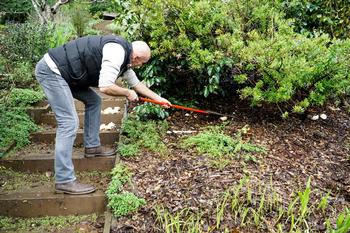Dormant spray
-
Martha Proctor
-
The chill in the autumn air reminds gardeners that it's time to start winter chores. Spraying of dormant oils on deciduous fruit and nut trees, roses, and other ornamentals can diminish the incidence of insect or fungal disease as cooler weather arrives. When applied to the point of runoff to the branches and trunk of fruit trees, these sprays plug the pores through which aphids, spider mites, psyllids, thrips and, scale etc, breathe, thus suffocating overwintering insects and eggs. Dormant sprays also kill fungi (e.g., shot hole disease, peach curl, brown rot, powdery mildew, and other fungal diseases) that are trapped and growing in the bark, cracks, and crevices of fruit trees.
 Dormant spraying a fruit tree in a West Marin garden. Photo: Martha Proctor
Dormant spraying a fruit tree in a West Marin garden. Photo: Martha ProctorDormant sprays, when mixed with water, are highly refined petroleum products or vegetable oils used for applying pesticides to plants and trees in their dormant stage after all or most of their leaves have fallen. Thorough application and coverage are essential as many insects prefer the underside of leaves or reside under sepals or buds that are hard to reach. Don't spray unless you have confirmed that the insects are present in damaging numbers and cannot be controlled by any other means. Wear protective gear, long sleeves, and long pants when spraying. Don't swallow, inhale, or expose your skin and eyes to the oil.
Proper timing is critical. Dormant oils should be applied at the beginning of dormancy in late November and again during leaf bud swell, just before buds begin to open in February or early March. The timing coincides with the increasing activity of the larvae of overwintering insects. These oils are temperature sensitive, so apply on a clear, non-windy day in the 50oF to 70oF temperature range when the temperature is not expected to drop to freezing for 24 hours after application.
A good time to apply dormant oil is right after a period of rain or foggy weather. Do not apply to drought-stressed trees or to any tree during fog, rain, or during or prior to hot or freezing weather. If it rains within hours of application, reapply the treatment. Do not treat within 30 days before or after applications of sulfur or certain other fungicides to avoid damage to trees. Dormant oil applications are not appropriate on citrus or avocado trees as these species do not enter a winter dormancy.
When mixing up spray solutions, mix less than you think you'll need, as disposal of leftovers is difficult. Estimate the amount your trees will need for good coverage by doing a test spray using water. Always follow the directions on the container label. Although horticultural or dormant oils leave no residue, so they have limited impact on pets, wildlife, and beneficial insects, they are toxic to fish. Carefully follow the listed precautions with regard to protecting bees by only spraying in the early morning or late evening. Raking up dead leaves to avoid overwintering pests. Photo: Martha Proctor
Raking up dead leaves to avoid overwintering pests. Photo: Martha ProctorDormant sprays should only be used in conjunction with good garden sanitation. Incorporating good cultural practices in your garden maintenance program will set the stage for more successful pest management. Rake and dispose of fallen leaves around your fruit tree in the green can. Space tree plantings and prune to provide good air circulation and light penetration. Avoid overhead irrigation; plant fruit trees in full sun.
By applying dormant oils annually as directed to well-maintained fruit trees, you will help protect your trees from several overwintering insects and prevent damage to flower and foliage tissue. Sanitation and dormant sprays are the "ounce of prevention" that will save you a pound of cure next spring. If appropriately used, horticultural oils can be a less toxic approach to controlling many overwintering pests than chemically based insecticides or fungicides.


